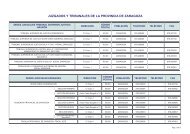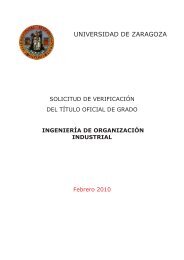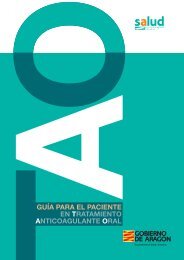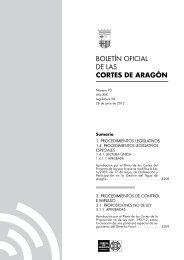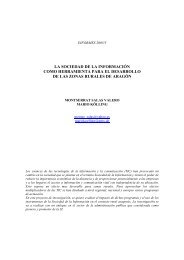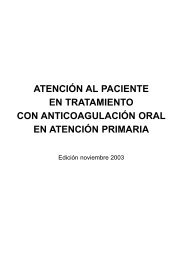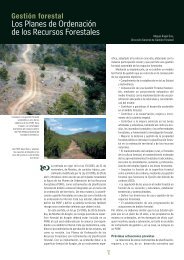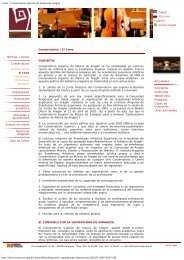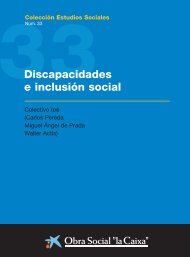Educación para todos: el imperativo de la calidad - unesdoc - Unesco
Educación para todos: el imperativo de la calidad - unesdoc - Unesco
Educación para todos: el imperativo de la calidad - unesdoc - Unesco
You also want an ePaper? Increase the reach of your titles
YUMPU automatically turns print PDFs into web optimized ePapers that Google loves.
0<br />
0<br />
5<br />
108 / CAPÍTULO 3<br />
2<br />
Informe <strong>de</strong> Seguimiento <strong>de</strong> <strong>la</strong> <strong>Educación</strong> <strong>para</strong> Todos en <strong>el</strong> Mundo<br />
El África<br />
Subsahariana y<br />
Asia Meridional y<br />
Occi<strong>de</strong>ntal cuentan<br />
<strong>de</strong> por sí so<strong>la</strong>s con<br />
un 75% <strong>de</strong> los<br />
niños sin<br />
esco<strong>la</strong>rizar d<strong>el</strong><br />
mundo entero.<br />
Niños sin esco<strong>la</strong>rizar<br />
Pese a los progresos <strong>de</strong> <strong>la</strong> esco<strong>la</strong>rización a lo<br />
<strong>la</strong>rgo d<strong>el</strong> <strong>de</strong>cenio <strong>de</strong> 1990 en una mayoría <strong>de</strong><br />
países en <strong>de</strong>sarrollo, un gran número <strong>de</strong> niños<br />
en edad <strong>de</strong> cursar <strong>la</strong> enseñanza primaria siguen<br />
excluidos d<strong>el</strong> sistema esco<strong>la</strong>r. La estimación<br />
más fácilmente disponible d<strong>el</strong> número <strong>de</strong> esos<br />
“niños excluidos <strong>de</strong> <strong>la</strong> escu<strong>el</strong>a” se efectúa<br />
basándose en <strong>la</strong> TNE, si bien este método<br />
sobreestima levemente <strong>el</strong> número real <strong>de</strong> los<br />
niños sin esco<strong>la</strong>rizar, ya que algunos <strong>de</strong> los que<br />
tienen edad <strong>para</strong> cursar <strong>la</strong> enseñanza primaria<br />
están esco<strong>la</strong>rizados en centros <strong>de</strong> preprimaria<br />
y otros, en algunos casos, en <strong>la</strong> enseñanza<br />
secundaria.<br />
En <strong>el</strong> Cuadro 3.3 se presentan <strong>la</strong>s estimaciones<br />
d<strong>el</strong> número <strong>de</strong> niños sin esco<strong>la</strong>rizar<br />
en 1998 y 2001 7 . En este año, su número<br />
ascendía a unos 103 millones, <strong>de</strong>spués <strong>de</strong> una<br />
lenta disminución <strong>de</strong> <strong>la</strong>s cifras registradas en<br />
1998 (106,9 millones) y 2000 (104,1 millones).<br />
Es evi<strong>de</strong>nte que <strong>la</strong>s tasas <strong>de</strong> esco<strong>la</strong>rización no<br />
aumentan con <strong>la</strong> rapi<strong>de</strong>z suficiente <strong>para</strong> que <strong>la</strong><br />
EPU se convierta en una realidad a p<strong>la</strong>zo corto,<br />
o incluso a p<strong>la</strong>zo medio. En <strong>el</strong> p<strong>la</strong>no mundial,<br />
le TNE ha aumentado, pasando <strong>de</strong> un 81,7%<br />
en 1990 a un 84% en 2001. Si esta ten<strong>de</strong>ncia<br />
persiste, <strong>la</strong> TNE alcanzará <strong>el</strong> 85% en 2005 y <strong>el</strong><br />
87% en 2015. La distribución por región <strong>de</strong> los<br />
niños sin esco<strong>la</strong>rizar refleja naturalmente <strong>la</strong> TNE<br />
y <strong>la</strong>s cifras <strong>de</strong>mográficas. Un 96% <strong>de</strong> los niños<br />
sin esco<strong>la</strong>rizar viven en los países en <strong>de</strong>sarrollo.<br />
El África Subsahariana y Asia Meridional y<br />
Cuadro 3.3: Número <strong>de</strong> niños sin esco<strong>la</strong>rizar, por región (1998 y 2001)<br />
Mundo<br />
1998<br />
Total Varones Niñas<br />
Occi<strong>de</strong>ntal cuentan <strong>de</strong> por sí so<strong>la</strong>s con un 75%<br />
<strong>de</strong> los niños sin esco<strong>la</strong>rizar d<strong>el</strong> mundo entero.<br />
Un 57% <strong>de</strong> esos niños son niñas y esta proporción<br />
alcanza o rebasa <strong>el</strong> 60% en los Estados<br />
Árabes y Asia Meridional y Occi<strong>de</strong>ntal.<br />
Progresión <strong>de</strong> los alumnos:<br />
<strong>la</strong> cantidad, unida a <strong>la</strong> <strong>calidad</strong><br />
Es necesario llegar a matricu<strong>la</strong>r a <strong>todos</strong> los<br />
niños en <strong>la</strong> enseñanza primaria <strong>para</strong> lograr<br />
<strong>la</strong> EPU, pero esto no es suficiente <strong>de</strong> por sí.<br />
La EPU exige a<strong>de</strong>más que en todas partes los<br />
niños terminen por completo (o, <strong>para</strong> ser más<br />
realistas, casi por completo) <strong>el</strong> p<strong>la</strong>n <strong>de</strong> estudios<br />
<strong>de</strong> primaria, lo cual es imposible si <strong>la</strong>s escu<strong>el</strong>as<br />
no poseen una <strong>calidad</strong> suficiente. La evaluación<br />
<strong>de</strong> <strong>la</strong> progresión <strong>de</strong> los alumnos en <strong>la</strong> escu<strong>el</strong>a<br />
primaria proporciona indicaciones sobre otros<br />
aspectos cuantitativos d<strong>el</strong> sistema esco<strong>la</strong>r, así<br />
como un primer enfoque <strong>de</strong> <strong>la</strong> evaluación <strong>de</strong><br />
<strong>la</strong> <strong>calidad</strong>.<br />
Esco<strong>la</strong>rizaciones tardías<br />
Una primera cuestión es <strong>la</strong> <strong>de</strong> <strong>la</strong> edad a <strong>la</strong> que<br />
los niños ingresan por primera vez en <strong>la</strong> escu<strong>el</strong>a.<br />
Aunque se supone que oficialmente <strong>la</strong> esco<strong>la</strong>ridad<br />
en <strong>la</strong> enseñanza primaria comienza a los 5<br />
o 6 años <strong>de</strong> edad en <strong>la</strong> mayoría <strong>de</strong> los países, <strong>la</strong>s<br />
esco<strong>la</strong>rizaciones tardías su<strong>el</strong>en ser frecuentes<br />
en <strong>todos</strong> los países en <strong>de</strong>sarrollo por distintos<br />
motivos, por ejemplo <strong>la</strong> participación <strong>de</strong> los niños<br />
en <strong>la</strong>s activida<strong>de</strong>s económicas <strong>de</strong> sus familias y<br />
<strong>la</strong> dificultad <strong>de</strong> <strong>de</strong>sp<strong>la</strong>zarse a pie a escu<strong>el</strong>as que<br />
2001<br />
Total Varones Niñas<br />
% <strong>de</strong><br />
Miles<br />
niñas<br />
Miles<br />
106 916 44 062 62 853 59 103 466 44 985 58 481<br />
% <strong>de</strong><br />
niñas<br />
57<br />
Países en <strong>de</strong>sarrollo<br />
Países <strong>de</strong>sarrol<strong>la</strong>dos<br />
Países en transición<br />
101 905 41 537 60 368 59 99 056 42 667 56 389<br />
2 447 1 251 1 196 49<br />
2 992 1 612 1 380<br />
2 563 1 274 1 289 50<br />
1 419 706 713<br />
57<br />
46<br />
50<br />
7. El número <strong>de</strong> niños sin<br />
esco<strong>la</strong>rizar es <strong>el</strong><br />
suministrado por <strong>la</strong>s<br />
estimaciones <strong>de</strong> 2004 d<strong>el</strong><br />
IEU, que está basado en <strong>la</strong><br />
última revisión <strong>de</strong> los datos.<br />
Para una explicación <strong>de</strong><br />
<strong>la</strong>s revisiones <strong>de</strong> datos<br />
prece<strong>de</strong>ntes, véase UNESCO<br />
(2003a, pág 50).<br />
África Subsahariana<br />
América d<strong>el</strong> Norte y Europa Occi<strong>de</strong>ntal<br />
América Latina y <strong>el</strong> Caribe<br />
Asia Central<br />
Asia Meridional y Occi<strong>de</strong>ntal<br />
Asia Oriental y <strong>el</strong> Pacífico<br />
Estados Árabes<br />
Europa Central y Oriental<br />
Nota: Las sumas <strong>de</strong> <strong>la</strong>s cifras pue<strong>de</strong>n no ser iguales a los totales indicados porque se han redon<strong>de</strong>ado.<br />
Fuente: Anexo Estadístico, Cuadro 5.<br />
43 082 19 736 23 346 54 40 291 18 301 21 990<br />
1 884 967 917 49<br />
2 386 1 301 1 085<br />
3 759 1 699 2 059 55<br />
2 468 1 300 1 168<br />
879 429 450 51<br />
390 169 222<br />
37 410 12 179 25 231 67 35 808 13 518 22 289<br />
7 830 3 912 3 917 50 11 993 6 159 5 835<br />
8 491 3 501 4 991 59<br />
7 441 2 992 4 450<br />
3 581 1 640 1 941 54<br />
2 688 1 245 1 443<br />
55<br />
45<br />
47<br />
57<br />
62<br />
49<br />
60<br />
54



